Mustache & Sideburn Transplants: Design Principles, Costs & Recovery
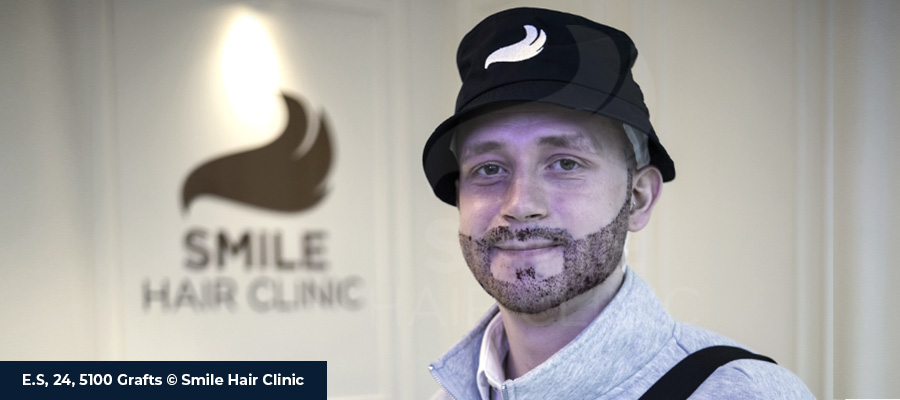
Publish Date: 9 October 2025
Facial hair plays a major role in shaping masculine aesthetics. A well-defined mustache or naturally blended sideburns can completely transform a man’s appearance. For those with patchy or thin facial hair, a mustache transplant or sideburn transplant offers a lasting solution that looks and feels authentic.
Unlike a full beard transplant, these procedures require careful precision and artistry. The mustache and sideburn zones are smaller, more visible, and must match existing hair growth patterns exactly. That is why mustache and sideburn transplant surgeries are performed by specialists skilled in symmetry, density control, and fine facial hair transplant design.
The procedure typically uses follicular unit extraction (FUE) or follicular unit transplantation (FUT) to move single-hair grafts from the donor area to the upper lip and side regions. The goal is to achieve a natural facial hair restoration with consistent texture, correct follicular angle alignment, and balanced density.
“Every face has its own pattern. Designing a natural mustache line or sideburn flow requires an understanding of facial proportions and individual hair direction.” — Dr. Mehmet Erdoğan
This guide covers everything you need to know about mustache and sideburn transplants, including:
- The key design principles behind natural and symmetrical results
- A detailed breakdown of mustache transplant cost and regional pricing differences
- The full facial transplant recovery timeline, from surgery to regrowth
- Realistic expectations for mustache transplant results and long-term maintenance
With the clear understanding of each stage of the process, patients can make informed decisions and achieve the balanced, confident look they’ve always wanted.
Facial Hair Zone Mapping & Design Principles
The success of a mustache transplant or sideburn transplant depends on careful planning and precise design. Each area of the face has unique angles, thickness, and hair directions that must be respected to create a realistic result. A skilled surgeon approaches the facial hair transplant design as both a medical and artistic process.
About Facial Hair Zones
The mustache and sideburns belong to separate aesthetic regions. The mustache covers the philtrum, upper lip corners, and sometimes extends slightly toward the beard line. The sideburns connect the hairline to the lower cheek, framing the face and adding definition. Designing these zones requires accurate recipient site design and awareness of facial skin characteristics, which differ from the scalp.
- Mustache Zone: Requires soft curvature and moderate density for a natural appearance.
- Sideburn Zone: Needs gradual tapering and smooth transition into beard or temple hair.
Mustache & Sideburn Design Principles
Creating a natural mustache line relies on maintaining balance between density and direction. Facial graft direction and angle must mimic natural growth to avoid stiffness or asymmetry. For sideburn reconstruction, the surgeon ensures the top blends seamlessly into temple hair while the lower section aligns with jaw contour.
Key design elements include:
- Symmetrical facial hair design based on facial proportions
- Graft density per cm² adjusted by area (higher at the center, lighter at edges)
- Texture matching between donor and recipient hairs
- Micrograft technique for uniform distribution of single-hair grafts
“The artistry lies in details. A well-planned design with perfect angle alignment and density control ensures that transplanted hair blends flawlessly with existing growth.” — Dr. Gökay Bilgin
Candidate Selection & Pre-Op Planning
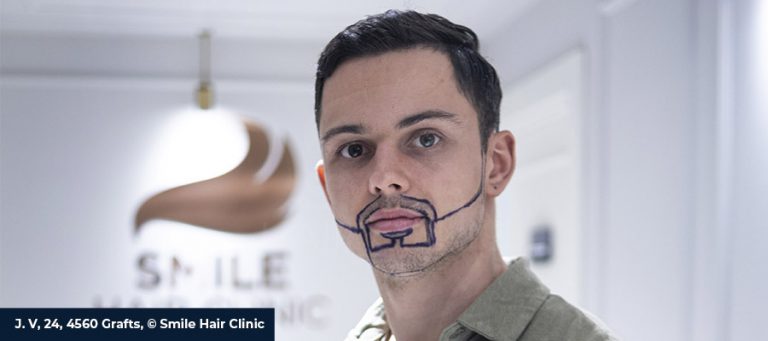
Not everyone requires a full beard transplant. Many men only want to enhance their upper lip or fill patchy sideburns. Before deciding on a mustache transplant or sideburn transplant, it’s important to determine whether you’re a good candidate and how the procedure should be planned.
Ideal Candidates
A suitable patient for facial hair restoration typically meets these conditions:
- Sparse or missing hair in the mustache or sideburn areas
- Stable donor hair on the back or sides of the scalp
- Realistic expectations about density and coverage
- No active skin disorders, infections, or keloid tendencies
- Commitment to proper mustache transplant aftercare and recovery steps
Those with scars or uneven growth from previous injuries or surgeries may also benefit from sideburn reconstruction or sideburn restoration surgery, which can cover visible marks and restore natural framing to the face.
Donor Area Evaluation
The donor zone, usually the back of the scalp, must have hair similar in thickness and texture to facial hair. Since mustache and sideburn zones use finer single-hair grafts, the surgeon selects follicles carefully to ensure consistency. Donor area harvesting must be performed with gentle extraction to preserve graft survival rate.
Planning the Procedure
Before surgery, the doctor creates a custom recipient site design based on the patient’s face shape, hairline, and growth direction. Each follicular angle alignment is mapped to replicate natural facial flow. The micrograft technique is preferred for precision, as it allows placement of small, single follicles that blend seamlessly.
Pre-operative steps include:
- Avoiding alcohol, smoking, and blood-thinning medications for one week
- Maintaining good hydration and nutrition
- Washing the donor area with antiseptic shampoo before surgery
“A well-prepared donor area and personalized design plan are the foundation of any successful mustache or sideburn transplant.” — Dr. Mehmet Erdoğan
Meticulous planning ensures every graft is placed with purpose, leading to balanced, natural results that match existing facial patterns.
Techniques & Surgical Adaptations
Performing a mustache transplant or sideburn transplant requires exceptional precision. These areas are smaller than the scalp yet demand perfect angle, direction, and density. The two most advanced techniques used today for facial hair restoration are FUE and DHI.
Modern Techniques
Follicular Unit Extraction (FUE):
This method is the foundation of most facial hair transplant surgeries. In FUE, follicles are extracted one by one from the donor area using micro-punch tools. Each single-hair graft is preserved carefully to maintain a high graft survival rate. The technique minimizes scarring and provides flexibility for artistic recipient site design, especially for fine areas like the mustache and sideburns.
Direct Hair Implantation (DHI):
DHI builds upon FUE by eliminating the need to create recipient incisions beforehand. Instead, grafts are implanted directly using a Choi implanter pen. This allows surgeons to control facial graft direction and angle more precisely and adjust graft density per cm² on the go. DHI is particularly suited for achieving perfect follicular angle alignment in facial zones, where every millimeter matters.
Technique Adaptations for Facial Zones
Facial skin is thinner and more vascular than the scalp, requiring gentle handling.
- For the mustache, grafts are implanted at very shallow angles to follow the natural upper lip curve.
- For sideburns, the grafts are placed diagonally downward, merging naturally with temple or beard hair.
The micrograft technique and DHI precision allow for customized density that appears completely natural.
“Facial grafts must follow the natural curvature of the face. Even a few degrees of error can alter the look entirely.” — Dr. Gökay Bilgin
Modern FUE and DHI methods have made mustache transplant techniques more refined than ever, providing soft texture, accurate alignment, and authentic facial hair transplant results.
Cost Breakdown & Pricing Models
Understanding mustache transplant cost and sideburn transplant pricing is essential for planning a realistic treatment. Modern techniques like FUE and DHI differ in cost because of the equipment, surgeon time, and precision they require.
What Affects Cost
The total facial hair transplant price varies based on:
- Technique Used: DHI is generally more expensive than FUE due to its advanced implantation pens and surgeon involvement during every graft placement.
- Graft Count: Mustache and sideburn zones require between 300–1,200 grafts, depending on thickness and design.
- Surgeon Expertise: Clinics specializing in facial hair transplant design and symmetry often charge higher rates.
- Geographic Location: Prices are lower in medical tourism hubs like Turkey compared to the US or UK.
- Package Inclusions: Some clinics offer mustache transplant packages including transport, hotel, and post-care.
Typical Price Range
| Procedure Type | Average Grafts | Price Range (USD) | Technique Commonly Used |
|---|---|---|---|
| Mustache Transplant | 400–800 | $1,000–$2,200 | FUE or DHI |
| Sideburn Transplant | 300–600 per side | $900–$1,800 | FUE or DHI |
| Combined Mustache + Sideburn Transplant | 1,000–1,400 | $1,800–$3,200 | Mostly DHI |
In Turkey, mustache transplant cost Turkey averages $1,200–$1,600 for 600 grafts using DHI. While FUE remains more affordable, DHI offers superior control over facial graft placement, resulting in more natural density and flow.
Choosing the Right Option
- FUE is efficient and cost-effective for larger areas.
- DHI is ideal for detailed zones such as mustache, goatee, or sideburn reconstruction.
- Always confirm the surgeon’s experience in DHI facial applications, as mastering implantation angles is crucial for success.
“DHI allows surgeons to place each graft at its ideal depth and direction, giving more natural and uniform facial results.” — Dr. Mehmet Erdoğan
Recovery & Healing Timeline
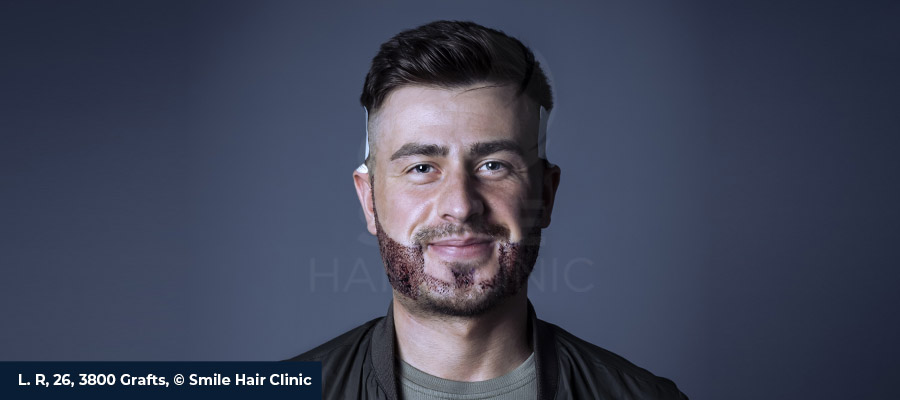
After a mustache transplant or sideburn transplant, recovery is relatively quick, especially with FUE and DHI methods. Since these techniques use micro-sized incisions and gentle implantation, the healing process is smoother and more comfortable than older procedures.
Day 0–3: Initial Healing
Right after surgery, the treated areas may show mild redness and post-operative edema. Small scabs form around each graft, protecting the follicles during the early healing phase. Patients are advised to keep the area dry, avoid touching, and sleep with the head slightly elevated to minimize swelling.
Mild swelling after facial transplant is normal, particularly around the upper lip and sideburns. It usually subsides within a few days.
Day 4–7: Scab Shedding & First Wash
By the end of the first week, gentle cleansing begins. Clinics usually provide detailed mustache transplant aftercare instructions that include saline sprays or mild shampoos. The scabs gradually fall off, revealing newly implanted follicles.
It’s essential not to scratch or rub during this period to protect the delicate grafts. Patients should also avoid hot showers, sun exposure, and heavy workouts.
Week 2–4: Transitional Phase
During this stage, temporary shedding known as facial graft shedding may occur. This is a natural reaction where transplanted hairs fall before regrowing stronger. The underlying follicles remain intact, preparing for new growth in the next months.
By the end of the first month, the skin color evens out, and patients can resume most daily activities.
Month 2–6: Visible Growth
New facial hairs begin to appear around month two. Mustache growth after transplant becomes noticeable by month three, while sideburn hair growth follows a similar pattern. Patients can expect steady density improvement and more defined texture by month six.
“Patience is key. Facial transplants follow the same growth cycle as scalp grafts, but early results already give a preview of the final shape.” — Dr. Gökay Bilgin
Month 6–12: Final Results
By the one-year mark, patients can enjoy full mustache transplant results with natural direction, density, and styling flexibility. DHI often accelerates recovery thanks to its minimal trauma and precise implantation.
Proper care during the first few weeks is vital to maintain an excellent graft survival rate and achieve lifelong results.
Outcomes, Risks & Revisions
When performed with modern FUE or DHI techniques, both mustache transplant and sideburn transplant procedures deliver highly natural and permanent results. Because these zones are small but visually dominant, even subtle improvements can have a powerful impact on facial appearance and confidence.
Expected Results
Patients typically see gradual improvement over several months. The transplanted follicles enter a short resting phase before producing new, thicker hairs. By 6 to 8 months, visible mustache growth after transplant and sideburn hair growth emerge with natural texture and direction.
Once mature, the transplanted hair can be trimmed, styled, or shaved like natural facial hair. Since the grafts are taken from the scalp, they maintain lifelong growth characteristics. Mustache transplant results are permanent, and sideburns blend seamlessly with existing beard or temple hair once the density stabilizes.
Common Risks and How to Minimize Them
While modern methods make complications rare, understanding potential issues helps patients maintain realistic expectations:
- Minor redness or swelling: A normal part of early healing.
- Folliculitis or small pimples: Can occur when new hairs start to grow; easily treated with mild care.
- Uneven density: Usually corrected with a touch-up session after full growth is assessed.
- Scarring: Extremely minimal in FUE and DHI, especially with experienced surgeons.
- Delayed growth: Occasionally caused by poor post-care or health factors; improved with nutritional support or PRP.
Proper mustache transplant aftercare and clinic follow-up greatly reduce risks. Selecting a surgeon experienced in facial hair transplant design ensures accurate follicular angle alignment and consistent graft survival rate.
Revision & Enhancement Options
In rare cases where density or design requires refinement, a minor facial hair transplant revision can be done 10–12 months later. This typically involves adding small single-hair grafts for balance or redefining the natural mustache line and sideburn contours.
“Revisions are rare but sometimes necessary for perfect symmetry. DHI allows easy enhancement without disrupting existing grafts.” — Dr. Mehmet Erdoğan
With proper planning and expert technique, long-term satisfaction rates exceed 95%, making mustache and sideburn transplants one of the most rewarding procedures in male facial restoration.
Case Studies & Gallery
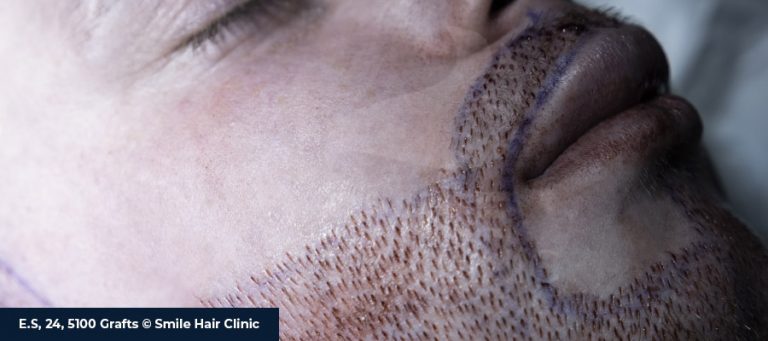
Real patient experiences highlight how modern mustache transplant and sideburn transplant procedures can transform appearance while maintaining a natural, balanced look. Each result depends on the patient’s donor capacity, facial structure, and the precision of the surgeon performing the facial hair restoration.
Case Study 1 – Mustache Redesign with DHI
A 32-year-old patient with sparse upper lip hair underwent a mustache transplant using 550 grafts via Direct Hair Implantation (DHI). Each graft was placed following the natural curvature of the philtrum and upper lip.
- Technique: DHI
- Grafts: 550 single-hair grafts
- Result: Full coverage with balanced symmetry by month six
- Observation: Natural texture and direction with minimal post-operative redness
“For precise areas like the mustache, DHI allows direct control of graft direction, producing soft and realistic results.” — Dr. Gökay Bilgin
Case Study 2 – Sideburn Reconstruction After Scarring
A 40-year-old patient sought sideburn restoration surgery after a previous injury left visible gaps. 700 grafts were transplanted evenly on both sides using FUE. The surgeon paid special attention to facial graft direction and angle to match temple and beard lines.
- Technique: FUE
- Grafts: 350 per side
- Result: Smooth, scar-free appearance and restored face symmetry
- Healing: Mild swelling resolved in three days, full growth by month eight
Case Study 3 – Combined Mustache & Sideburn Design
A 29-year-old man opted for a full mustache and sideburn transplant for stronger facial framing. 1,200 grafts were distributed using DHI, ensuring seamless transition from mustache corners to sideburns.
- Technique: DHI
- Grafts: 1,200
- Result: Defined mustache, dense sideburns, and natural facial harmony by one year
- Bonus: No visible scarring thanks to micro-extraction tools
Summary Table
| Case | Technique | Grafts Used | Zone | Visible Results | Final Outcome |
|---|---|---|---|---|---|
| 1 | DHI | 550 | Mustache | 6 months | Natural coverage |
| 2 | FUE | 700 | Sideburns | 8 months | Symmetrical restoration |
| 3 | DHI | 1,200 | Mustache + Sideburns | 12 months | Full facial framing |
Each of these examples demonstrates how individualized planning, micrograft technique, and expert design ensure consistent graft survival rates and authentic results that suit the patient’s natural look.
FAQs & Troubleshooting
How many grafts for mustache transplant?
A typical mustache transplant requires between 400 and 800 grafts, depending on density goals and facial shape. Some patients need fewer if they already have partial growth along the upper lip.
How many grafts for sideburn transplant?
A sideburn transplant usually needs 300 to 600 grafts per side. Patients seeking thicker or longer sideburns may require more grafts, especially for blending into beard or temple hair.
When does mustache transplant start growing?
Initial growth from transplanted follicles begins around 2–3 months after surgery. Full mustache growth after transplant generally appears between 6–9 months, with final thickness at one year.
Is sideburn transplant permanent?
Yes. The transplanted hair comes from the scalp’s permanent donor zone, meaning it retains lifelong growth characteristics. Sideburn hair growth will continue normally after full recovery.
When can I shave after mustache transplant?
Most surgeons recommend waiting 3–4 weeks before shaving or trimming. Early shaving can dislodge new grafts. Once healed, the transplanted hair can be styled just like natural facial hair.
How much does mustache transplant cost in Turkey?
The mustache transplant cost in Turkey typically ranges between $1,000 and $1,600, depending on technique (FUE or DHI), graft count, and surgeon experience. Facial hair transplant packages often include hotel stays and aftercare kits.
Can you get a mustache transplant without a beard transplant?
Yes. A mustache transplant can be performed independently for patients who only want upper lip enhancement. It can also be combined later with beard and mustache transplant procedures for a fuller look.
What is the healing time for facial hair transplant?
Most patients complete the facial hair transplant healing stages within 7–10 days. Redness and swelling fade during the first week, and shedding occurs by the end of the first month.
Does DHI hurt less than FUE?
Both are minimally invasive, but DHI may feel gentler since it eliminates pre-made incisions. The micrograft technique used in DHI results in faster healing and less irritation.
What if uneven growth appears during recovery?
Uneven density during the early stages is completely normal. Transplanted follicles grow in cycles, and full facial hair texture matching takes several months. Final refinement can be done after 12 months if needed.
Conclusion
A mustache transplant or sideburn transplant is much more than a cosmetic enhancement. It’s a carefully planned surgical design that restores symmetry, confidence, and character. With advanced FUE and DHI techniques, surgeons can achieve precise facial hair restoration that looks and feels completely natural.
When performed by experts, mustache and sideburn transplants deliver permanent results with minimal discomfort and short recovery. The key to success lies in three main elements:
- Technique: DHI offers superior control for direction and depth, ideal for detailed areas such as the mustache and sideburns.
- Design: Following accurate mustache design principles and sideburn design principles ensures realistic, symmetrical outcomes.
- Recovery: Healing typically takes 7–10 days, with visible growth by month 3 and full results within a year.
- Cost: Prices range from $1,000–$3,000 depending on graft count and location, with mustache transplant cost Turkey being the most affordable option for international patients.
- Result: A natural, permanent improvement in facial definition and hair texture.
“Every graft carries an artistic decision. When design meets medical precision, results become part of your natural expression.” — Dr. Mehmet Erdoğan
At Smile Hair Clinic, our team performs facial hair transplants using advanced DHI and FUE methods, ensuring accurate follicular angle alignment and seamless blending with your natural hair. Each treatment begins with a detailed consultation to plan the ideal recipient site design for your mustache and sideburn zones.
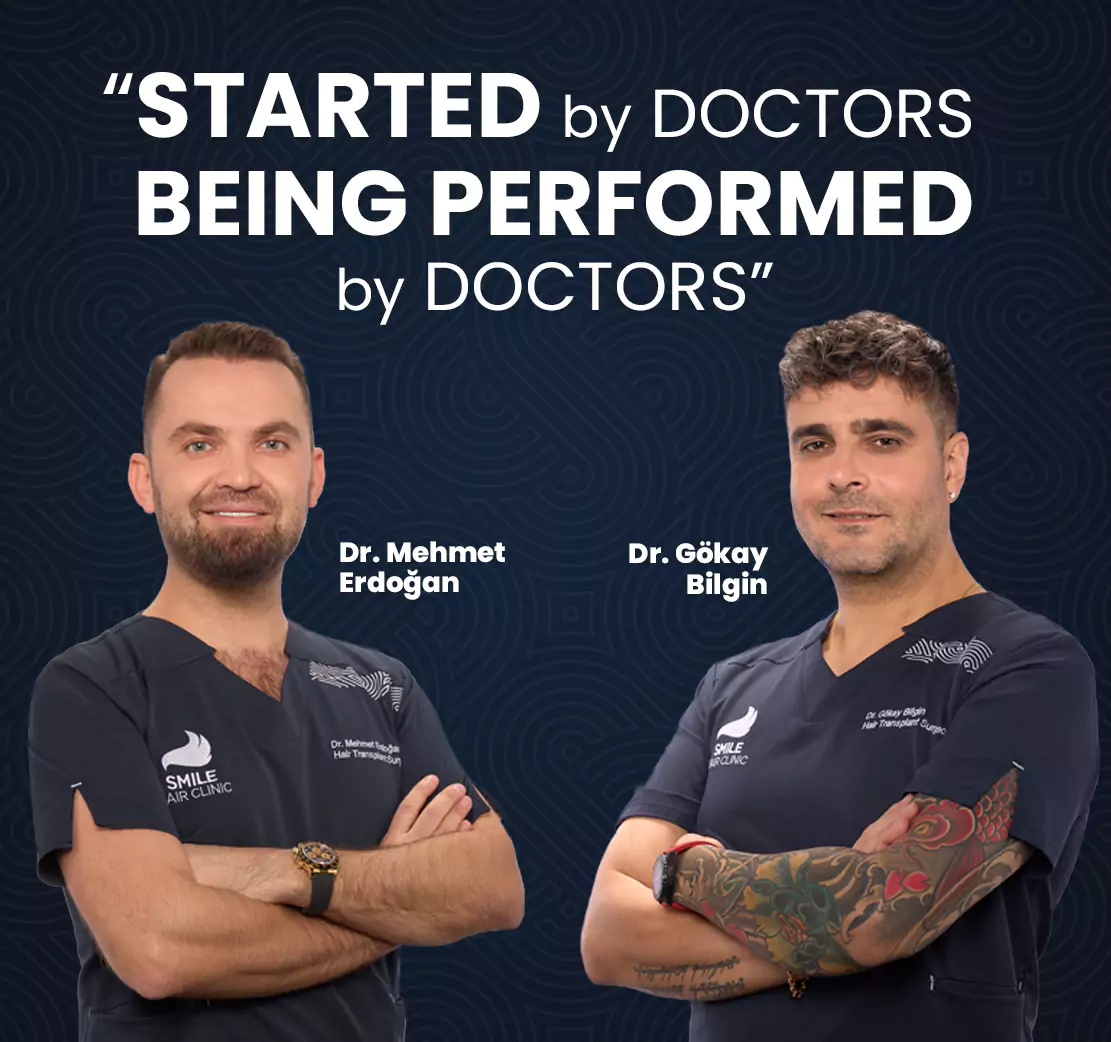
Our specialists focus on long-term results — from careful donor extraction to follow-up care — ensuring your mustache transplant results remain natural for years to come. Whether you are filling in patchy growth or redefining your facial frame, the process is safe, efficient, and fully personalized.
Book a consultation today to discuss your goals, review potential graft counts, and receive a clear cost estimate. Restore your confidence with a balanced, well-defined look that truly fits your style.
Last Update: 9 October 2025
 Whatsapp
Whatsapp